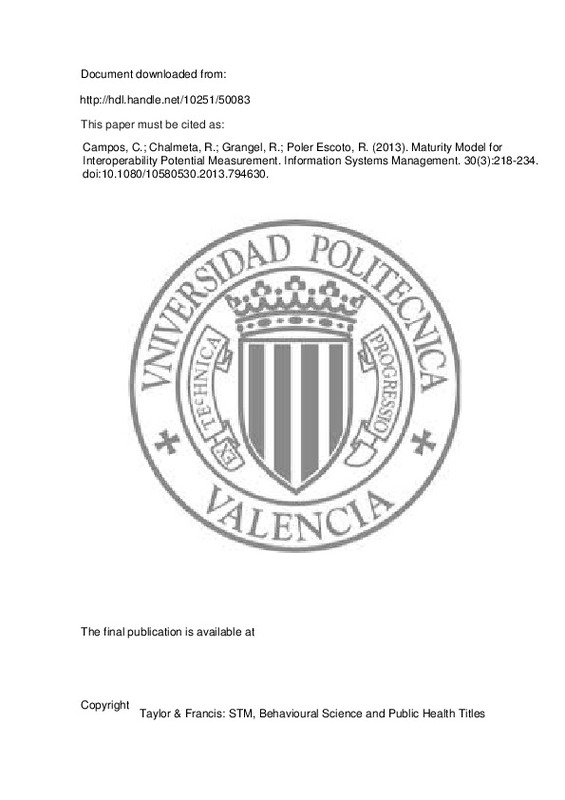JavaScript is disabled for your browser. Some features of this site may not work without it.
Buscar en RiuNet
Listar
Mi cuenta
Estadísticas
Ayuda RiuNet
Admin. UPV
Maturity Model for Interoperability Potential Measurement
Mostrar el registro sencillo del ítem
Ficheros en el ítem
| dc.contributor.author | Campos, Cristina
|
es_ES |
| dc.contributor.author | Chalmeta, Ricardo
|
es_ES |
| dc.contributor.author | Grangel, Reyes
|
es_ES |
| dc.contributor.author | Poler Escoto, Raúl
|
es_ES |
| dc.date.accessioned | 2015-05-12T07:31:30Z | |
| dc.date.available | 2015-05-12T07:31:30Z | |
| dc.date.issued | 2013 | |
| dc.identifier.issn | 1058-0530 | |
| dc.identifier.uri | http://hdl.handle.net/10251/50083 | |
| dc.description.abstract | Interoperability potential concerns the preparation level of an enterprise to establish an efficient collaboration with possible part- ners. In order to improve their interoperability, enterprises need to know witch level of maturity they have achieved. This article pro- poses a complete maturity model composed by a methodology and a reference set of parameters to measure interoperability potential. In order to clarify the proposal, an example of application in a real case is described. | es_ES |
| dc.language | Inglés | es_ES |
| dc.publisher | Taylor & Francis: STM, Behavioural Science and Public Health Titles | es_ES |
| dc.relation.ispartof | Information Systems Management | es_ES |
| dc.rights | Reserva de todos los derechos | es_ES |
| dc.subject | Interoperability measurement | es_ES |
| dc.subject | Interoperability potential | es_ES |
| dc.subject | Measurement parameters | es_ES |
| dc.subject | Maturity model | es_ES |
| dc.subject | Methodology | es_ES |
| dc.subject.classification | ORGANIZACION DE EMPRESAS | es_ES |
| dc.title | Maturity Model for Interoperability Potential Measurement | es_ES |
| dc.type | Artículo | es_ES |
| dc.identifier.doi | 10.1080/10580530.2013.794630 | |
| dc.rights.accessRights | Abierto | es_ES |
| dc.contributor.affiliation | Universitat Politècnica de València. Centro de Investigación de Gestión e Ingeniería de la Producción - Centre d'Investigació de Gestió i Enginyeria de la Producció | es_ES |
| dc.contributor.affiliation | Universitat Politècnica de València. Departamento de Organización de Empresas - Departament d'Organització d'Empreses | es_ES |
| dc.description.bibliographicCitation | Campos, C.; Chalmeta, R.; Grangel, R.; Poler Escoto, R. (2013). Maturity Model for Interoperability Potential Measurement. Information Systems Management. 30(3):218-234. doi:10.1080/10580530.2013.794630 | es_ES |
| dc.description.accrualMethod | S | es_ES |
| dc.description.upvformatpinicio | 218 | es_ES |
| dc.description.upvformatpfin | 234 | es_ES |
| dc.type.version | info:eu-repo/semantics/publishedVersion | es_ES |
| dc.description.volume | 30 | es_ES |
| dc.description.issue | 3 | es_ES |
| dc.relation.senia | 265050 | |
| dc.description.references | Alfaro, J. J., Rodriguez-Rodriguez, R., Verdecho, M. J., & Ortiz, A. (2009). Business process interoperability and collaborative performance measurement. International Journal of Computer Integrated Manufacturing, 22(9), 877-889. doi:10.1080/09511920902866112 | es_ES |
| dc.description.references | Sabucedo, L. Á., & Rifón, L. A. (2010). Managing Citizen Profiles in the Domain of e-Government: The cPortfolio Project. Information Systems Management, 27(4), 309-319. doi:10.1080/10580530.2010.514181 | es_ES |
| dc.description.references | Berre, A.-J., Elvesæter, B., Figay, N., Guglielmina, C., Johnsen, S. G., Karlsen, D., … Lippe, S. (s. f.). The ATHENA Interoperability Framework. Enterprise Interoperability II, 569-580. doi:10.1007/978-1-84628-858-6_62 | es_ES |
| dc.description.references | Blanc, S., Ducq, Y., & Vallespir, B. (2007). Evolution management towards interoperable supply chains using performance measurement. Computers in Industry, 58(7), 720-732. doi:10.1016/j.compind.2007.05.011 | es_ES |
| dc.description.references | Campos, C., Martí, I., Grangel, R., Mascherpa, A. and Chalmeta, R. A methodological proposal for the development of an interoperability framework.Model Driven Interoperability for Sustainable Information Systems (MDISIS′08) (CAiSE′08). Vol. 340, pp.47–57. CEUR-WS. http://ceur-ws.org/Vol-340/paper04.pdf | es_ES |
| dc.description.references | Chalmeta, R., & Grangel, R. (2005). Performance measurement systems for virtual enterprise integration. International Journal of Computer Integrated Manufacturing, 18(1), 73-84. doi:10.1080/0951192042000213164 | es_ES |
| dc.description.references | Doumeingts, G. and Chen, D. Basic concepts and approaches to develop interoperability of enterprise applications.PRO-VE,IFIP Conference Proceedings. Edited by: Camarinha-Matos, L. M. and Afsarmanesh, H. Vol. 262, pp.323–330. Norwell, MA: Kluwer. | es_ES |
| dc.description.references | Duque, A., Campos, C., Jimenez-Ruiz, E. and Chalmeta, R. An ontological solution to supprot interoperability in the textile industry.Second IFIP WG 5.8 International Workshop, IWEI 2009. Edited by: Poler, M. V. S. R. Vol. 38, pp.38–51. New York: Springer. | es_ES |
| dc.description.references | Guédria, W., Naudet, Y., & Chen, D. (2008). Interoperability Maturity Models – Survey and Comparison –. Lecture Notes in Computer Science, 273-282. doi:10.1007/978-3-540-88875-8_48 | es_ES |
| dc.description.references | Hoving, R. (2007). Information Technology Leadership Challenges — Past, Present, and Future. Information Systems Management, 24(2), 147-153. doi:10.1080/10580530701221049 | es_ES |
| dc.description.references | Palomares, N., Campos, C., & Palomero, S. (2010). How to Develop a Questionnaire in Order to Measure Interoperability Levels in Enterprises. Enterprise Interoperability IV, 387-396. doi:10.1007/978-1-84996-257-5_36 | es_ES |
| dc.description.references | Walsham, G. (1995). Interpretive case studies in IS research: nature and method. European Journal of Information Systems, 4(2), 74-81. doi:10.1057/ejis.1995.9 | es_ES |







![[Cerrado]](/themes/UPV/images/candado.png)

